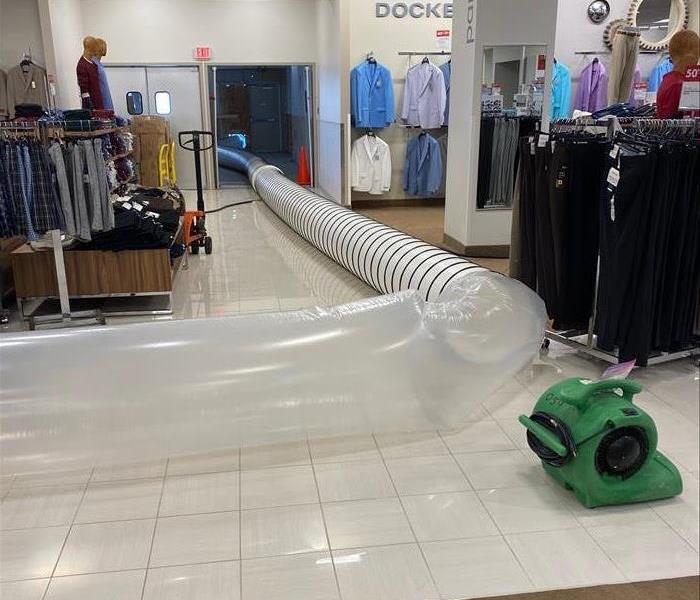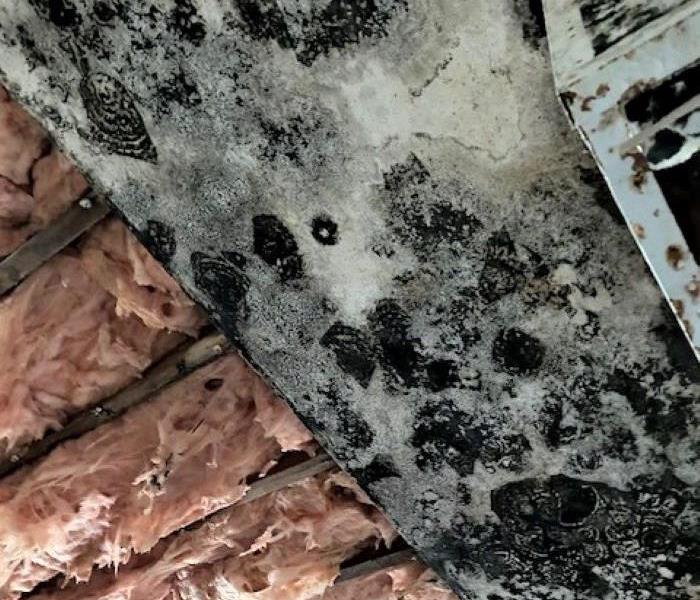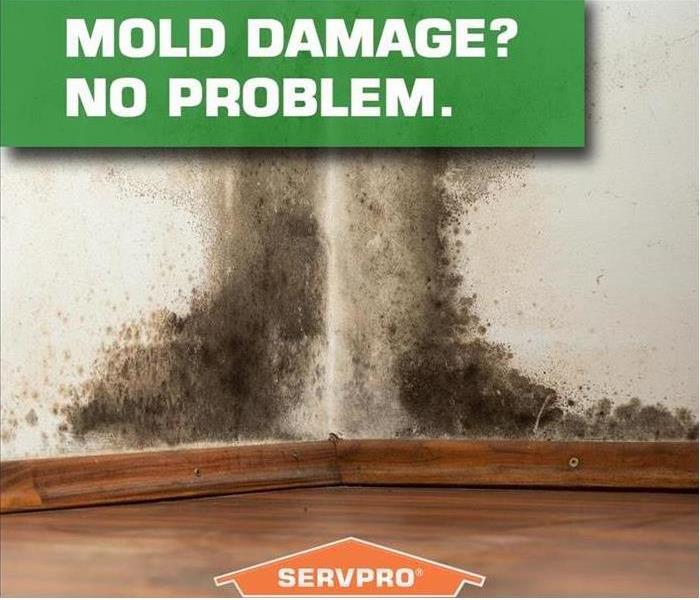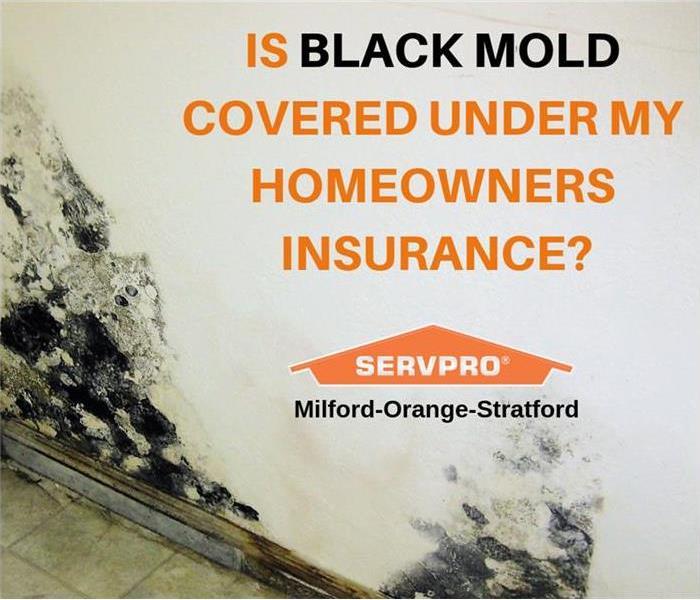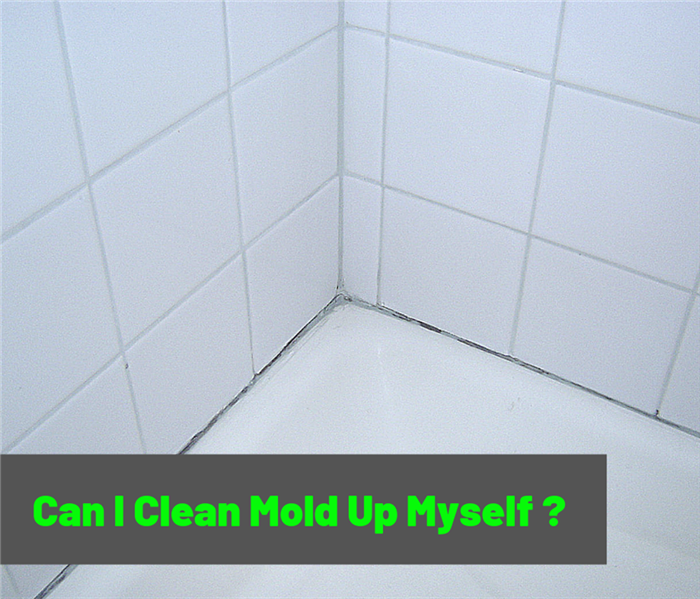Recent Mold Remediation Posts
Tackling Mold: A Guide to Effective Remediation in Commercial Properties
6/17/2024 (Permalink)
As a property manager or business owner, understanding and effectively addressing mold issues is crucial for maintaining a safe and functional environment.
Identifying the Problem
The first step in mold remediation is identification. Mold thrives in damp, humid environments and often hides in less visible areas such as behind walls, under flooring, or in HVAC systems. Signs of mold include musty odors, visible growth, and allergic reactions among occupants. Regular inspections and prompt action are essential to catching mold early before it spreads extensively.
Assessing the Scope
Once mold is detected, a thorough assessment of the affected areas is necessary. This involves determining the extent of the mold growth and identifying any underlying moisture issues that may be fueling its development. Professional mold inspectors can conduct comprehensive assessments using moisture meters, thermal imaging, and air quality tests to provide a clear picture of the problem.
Developing a Remediation Plan
With assessment results in hand, the next step is to develop a remediation plan tailored to your commercial property. This plan should outline specific strategies for mold removal and prevention, taking into account the type of mold present, affected surfaces, and the building's layout.
Key components of a remediation plan may include:
- Containment: Isolating the affected area to prevent mold spores from spreading to clean areas.
- Removal: Physical removal of mold-infested materials such as drywall, carpeting, or insulation that cannot be effectively cleaned.
- Cleaning: Thorough cleaning and disinfection of surfaces using appropriate mold remediation products.
- Moisture Control: Addressing underlying moisture sources through repairs to leaks, improving ventilation, or installing dehumidifiers.
- Prevention: Implementing measures to prevent future mold growth, such as regular inspections, maintaining proper humidity levels, and educating occupants about moisture control.
Long-Term Maintenance
To prevent future mold issues, ongoing maintenance and monitoring are key. Implementing a proactive maintenance plan that includes regular inspections, prompt repairs of leaks or moisture issues, and educating building occupants on mold prevention measures can help maintain a mold-free environment.
Clearing the Air: Understanding Mold Remediation Services
5/31/2024 (Permalink)
Mold - a four-letter word that can strike fear into the hearts of homeowners.
It's unsightly, it's smelly, and most importantly, it can pose serious health risks. But fear not, because mold doesn't have to be a permanent resident in your home. With our professional mold remediation services, you can reclaim your space and breathe easy once again.
What is Mold Remediation?
Mold remediation is the process of identifying, containing, and removing mold from indoor environments. It's not just about scrubbing away visible mold; it's about addressing the root cause of the problem and preventing future growth. Our mold remediation specialists are trained to assess the extent of mold infestation, develop a customized remediation plan, and restore your home to a safe and healthy condition.
The Mold Remediation Process
So, what does the mold remediation process entail? While the specifics may vary depending on the severity of the mold infestation and the unique characteristics of your home, the basic steps typically include:
1. Assessment: A thorough inspection of the affected areas to determine the extent of the mold infestation and identify any underlying moisture issues.
2. Containment: Isolating the contaminated areas to prevent mold spores from spreading to unaffected parts of the home.
3. Removal: Physical removal of mold-infested materials and surfaces using specialized tools and cleaning agents.
4. Cleaning and Sanitization: Thorough cleaning and disinfection of the affected areas to eliminate any remaining mold spores and prevent regrowth.
5. Restoration: Repairing or replacing damaged materials and addressing any underlying moisture issues to prevent future mold growth.
Choosing the Right Mold Remediation Company
When it comes to mold remediation, not all companies are created equal. Here are a few key factors to consider when selecting a mold remediation provider:
Experience and Expertise: Look for a company with a proven track record of successful mold remediation projects and certified technicians who are trained in industry best practices.
Comprehensive Services: Choose a company that offers a full range of mold remediation services, from inspection and testing to removal and prevention.
Reputation and Reviews: Do your research and read reviews from previous customers to ensure you're choosing a reputable and reliable company.
Customer Satisfaction: Look for a company that prioritizes customer satisfaction and offers transparent communication, prompt service, and guaranteed results.
Don't let mold take control of your home and your health. With SERVPRO®? of Milford-Orange-Stratford's professional mold remediation services, you can take proactive steps to eliminate mold and create a clean, healthy living environment for you and your family. Remember, when it comes to mold remediation, it's better to act sooner rather than later.
Can I Clean Up Mold By Myself?
1/8/2021 (Permalink)
When you find mold in your home, you may wonder whether it is something that you can clean up yourself or whether professional remediation is necessary.
You probably know that mold spores are airborne and if mold is present in a home, some people could get sick from it. However, what about just a little mold in the corner of your bathtub or found on a basement wall where there was a leak? Does every sign of mold require professional remediation or is some mold growth a potential do it yourself clean up?
In our work as mold remediation specialists, we inspect homes with mold on a regular basis. There are occasions when we are able to recommend to a homeowner that the mold in their home does not require professional remediation. For example, if the mold is confined to a small area and is growing on non porous substances such as glass, ceramic tile or metal, our services may not be needed.
However, if you discover mold in your home and it falls under one of the following situations, professional remediation is recommended.
- The mold covers a large area (greater than three feet by three feet, according to the Environmental Protection Agency).
- Mold develops after flooding with water that might be contaminated with sewage or other potentially hazardous substances.
- There is mold in your heating, ventilation, and air conditioning system.
- You have moldy wood that cannot be easily removed and replaced. In this case, the moldy area needs to be sanded and encapsulated instead, which significantly increases one’s exposure to mold.
- You suspect that you have hidden mold because you can smell mold but can't find it. Mold can potentially be growing in your subfloors, behind kitchen or bathroom cabinetry, in the attic, inside walls, under carpets, or in your crawlspace.
- You have a medical condition that might be made worse by increased exposure to mold, like asthma, environment allergies, or an immune system disorder.
- You are already experiencing symptoms of mold-related health effects.
We know that a mold infestation is never an enjoyable experience for homeowners. SERVPRO of Milford-Orange-Stratford has IICRC trained mold specialists that will make the mold remediation process as smooth as possible.
If you are wondering whether the mold in your home requires professional remediation, please call us at (203) 301-0500 to schedule a consultation.
Will My Homeowners Insurance Policy Cover Mold?
10/5/2020 (Permalink)
Our office staff receives several calls a week from homeowners who have discovered mold in their bathroom, on windowsills, in the attic or basement. With much attention around black mold and its potential to cause health effects, many homeowners don't want to take a chance when they see mold. However, not every home that we inspect requires professional remediation. In some situations, we are able to recommend a safe method in which homeowners can reduce their mold exposure and/or treat it themselves.
In the cases where there has been a mold infestation and our services were required, homeowners are often surprised to discover that their homeowner’s insurance does not cover mold remediation.
Some policies will cover mold under certain circumstances, while other policies may exclude mold. Typically, if your policy does not include mold remediation it can be added. However, we recommend that you call your insurance agent to learn more about mold coverage. It can be a preventative measure that can save you thousands.
If you see signs of mold please don’t hesitate to call SERVPRO of Milford-Orange-Stratford at (203) 301-0500.
Winter + Bathroom Skylight + No Ventilation = Mold Problem
1/7/2020 (Permalink)
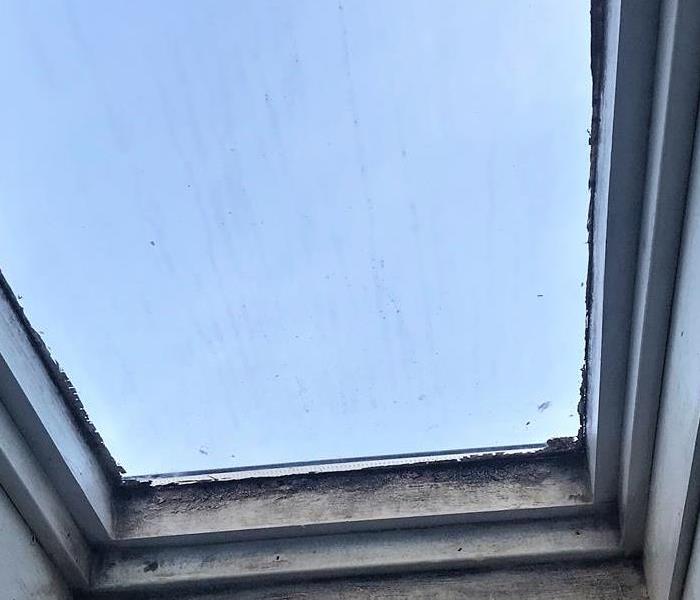 In the wintertime, the combination of cold air outside and warm, moist air inside this bathroom caused mold to grow around the skylight.
In the wintertime, the combination of cold air outside and warm, moist air inside this bathroom caused mold to grow around the skylight.
One of our Production Managers inspected a New Haven County home in which mold repeatedly grew around the skylight in the bathroom, despite the owner's efforts to remove it.
The homeowner had expressed surprise that the mold was growing in the wintertime. Many of us might have the same reaction- as there is a misconception that mold is more prevalent in the summertime. However, mold growth occurs in the winter due to the amount of melting snow and ice combined with the warm temperatures inside of a heated home. Although heated homes do tend to make the indoor air drier, places such as the bathroom, especially one with a lack of ventilation, experience increased moisture. Warm condensation collected daily on the cold, snow covered skylight in this case and the mold had an ideal breeding ground.
The first step in a mold remediation job for us is always to identify and correct the source of the mold. At this home, the problem was clearly a lack of ventilation combined with a skylight in the bathroom. The owner was not in a position to remove the skylight nor did they have any control over the weather outside. However, a high quality exhaust fan could be installed to help remove the warm moist air out of the bathroom. By taking this measure, the moist air was circulated out of the bathroom and the mold no longer grew. The affected area was cleaned and damaged wood replaced and the air filtered until the mold spore count was at normal levels. All in all, it was a relatively easy and inexpensive solution which took care of the mold problem.
When Mold is Present, the Type of Mold Matters.
10/15/2019 (Permalink)
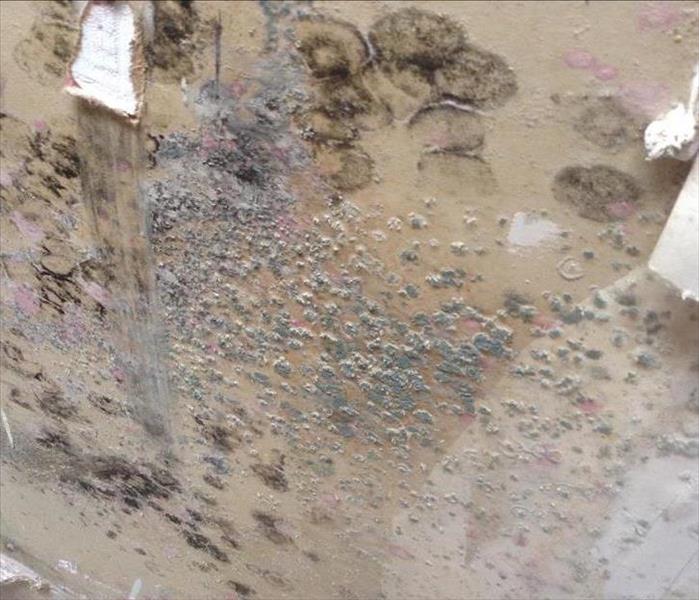 When you have mold in your home, the type of mold affects the treatment plan.
When you have mold in your home, the type of mold affects the treatment plan.
When a homeowner finds mold in their home, they often call us in a panic - concerned that their families health is being compromised.
And, in some cases, that is true however there are many different variables that determine whether the mold in your home is dangerous to your health. An important factor in the treatment of mold is what kind of mold is in your home. In this blog post, we discuss the common types of mold found in Connecticut homes.
Alternaria
Alternia is a commonly found mold which usually grows outdoors. That said, it can make its way into your home, where it grows in damp places such as the bathroom. The best way to keep this mold out of your home is to keep your windows and doors shut on the dry, windy days of summer, which is when it’s numbers are the most concentrated and likely to blow.
Aureobasidium
The aureobasidium mold grows indoors and is often found in the homes we treat. It grows on wooden furniture, surfaces, painted walls and wallpaper. You may also find it around windows and in caulk. If you notice a spotty substance that is pink and black in color in those areas, it’s most likely Aureobasidium
Chaetomium
When a home has mold due to water damage in which the drywall has gotten wet, the culprit is usually Chaetomium mold. A telltale sign is if you smell a musty or old odor in your home.
Fusarium
Fusarium is a mold that tends to grow in cold, wet areas and loves fabrics and carpeting. In our experience, it is often present in basements.
Penicillium
You know the name because of its use as an antibiotic. When airborne, though, Penicillium is a quick growing mold a mold that grows on insulation, furnishings, water damaged furniture, carpeting and more. Penicilium requires less moisture than other species of mold to survive, allowing it to be a fast growing and long surviving mold.
Stachybotrys Chartarum
The most demonized mold in the media, stachysbotrys chartarum is also called black mold or toxic mold. This is due to the fact that this type of mold creates toxic compounds known as mycotoxins that can negatively affect the health of humans. This type of mold can be identified by its musty smell and is found in areas that stay damp, like air conditioning pipes and ducts.
Trichoderma
Trichoderma is another damp area mold. Homeowners often find the trichoderma mold within damp carpeting, wallpaper and similar surfaces. Similar to stachysbotrys chartarum, it also creates mycotoxins.
We get it. Mold can be a frightening discovery and everybody has heard of somebody who has lived a nightmare because of its presence in their home. With professional remediation, however, your home can be made safe again.
You Found Mold in Your Home. Is Professional Mold Remediation Necessary?
5/28/2019 (Permalink)
When you find mold in your home, you may wonder whether it is something that you can clean up yourself or whether professional remediation is necessary.
You probably know that mold spores are airborne and if mold is present in a home, some people could get sick from it. However, what about just a little mold in the corner of your bathtub or found on a basement wall where there was a leak? Does every sign of mold require professional remediation or is some mold growth a potential do it yourself clean up?
In our work as mold remediation specialists, we inspect homes with mold on a regular basis. There are occasions when we are able to recommend to a homeowner that the mold in their home does not require professional remediation. For example, if the mold is confined to a small area and is growing on non porous substances such as glass, ceramic tile or metal, our services may not be needed.
However, if you discover mold in your home and it falls under one of the following situations, professional remediation is recommended.
- The mold covers a large area (greater than three feet by three feet, according to the Environmental Protection Agency).
- Mold develops after flooding with water that might be contaminated with sewage or other potentially hazardous substances.
- There is mold in your heating, ventilation, and air conditioning system.
- You have moldy wood that cannot be easily removed and replaced. In this case, the moldy area needs to be sanded and encapsulated instead, which significantly increases one’s exposure to mold.
- You suspect that you have hidden mold because you can smell mold but can't find it. Mold can potentially be growing in your subfloors, behind kitchen or bathroom cabinetry, in the attic, inside walls, under carpets, or in your crawlspace.
- You have a medical condition that might be made worse by increased exposure to mold, like asthma, environment allergies, or an immune system disorder.
- You are already experiencing symptoms of mold-related illness.
We know that a mold infestation is never an enjoyable experience for homeowners. SERVPRO of Milford-Orange-Stratford has IICRC trained mold specialists that will make the mold remediation process as smooth as possible.
If you are wondering whether the mold in your home requires professional remediation, please call us at (203) 301-0500 to schedule a consultation.
Does Your Insurance Policy Cover Mold Growing in Your Home?
3/11/2019 (Permalink)
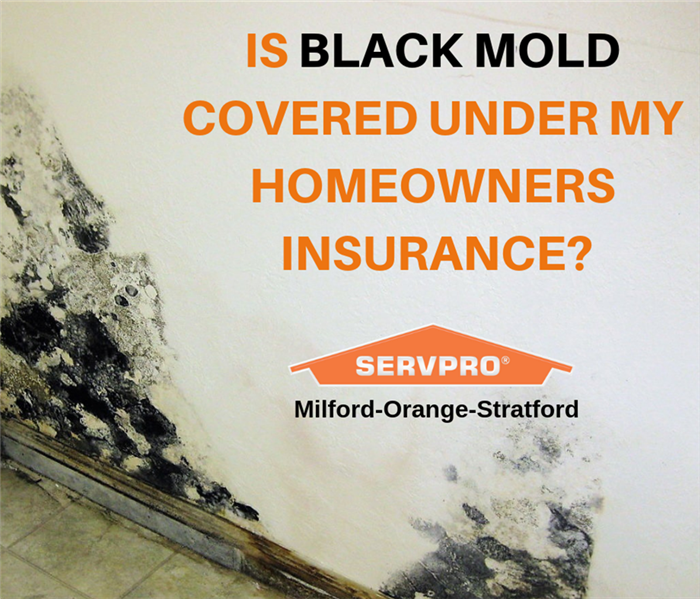 Mold remediation is covered under most homeowner's insurance policies if caused by water damage.
Mold remediation is covered under most homeowner's insurance policies if caused by water damage.
One of the most common questions that we receive in our Woodbridge office is whether mold damage remediation will be covered by a standard homeowner's insurance policy. It can be surprising to some homeowners to discover that their insurance policy does not cover mold.
While mold coverage varies from policy to policy, many insurance companies do not include damage caused by mold, fungi, and bacteria in their standard coverage. In particular, if the mold is a result of neglect such as the failure to address a leaking pipe, it is not typically covered. That said, when mold is caused by a sudden and unexpected event such as water damage from a burst pipe, the remediation is often covered.
We recommend that you call your insurance agent if the language of your policy is unclear. Some policies contain clauses that exclude mold. Some will cover mold removal only under certain circumstances. Typically, if your policy does not include mold remediation it can be added onto the policy. It's a smart preventative measure that can save you thousands in the future.
If you see signs of mold in your New Haven County home, call SERVPRO of Milford-Orange-Stratford at (203) 301-0500 to make an appointment for inspection. Our office staff has a wealth of experience with both homeowners and insurance companies and will help guide you through the mold remediation process.
Mold Growth Concerns in New Haven County Commercial HVAC Systems
12/28/2018 (Permalink)
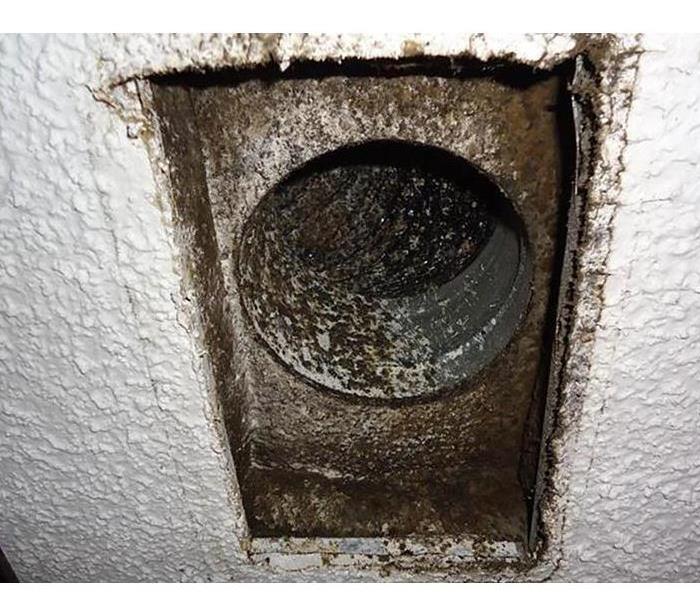 Mold in a commercial HVAC system is a serious concern.
Mold in a commercial HVAC system is a serious concern.
Mold Growth in Commercial Buildings is a Serious Concern in New Haven County.
Currently, there are concerns of mold growth and its affect on the health of students and teachers in Stamford, CT schools. With a number of teachers and students reporting negative health conditions that are consistent with mold exposure, this situation is not being taken lightly.
Mold is not always easy to find in places such as an HVAC system, where the dark and moist conditions provide an ideal breeding ground. Mold growth often goes unnoticed when hidden behind the walls and in the ceilings of a commercial structure. In particular, older buildings such as schools may be more susceptible because as a building ages, the pipes and roof may become compromised and allow water leakage, which can lead to mold growth.
If you suspect that there is mold in your school, office space or commercial building, call SERVPRO of Milford-Orange-Stratford at (203) 301-0500 for an assessment.
After Tornado Causes Water Damage in Oxford Homes, Mold Begins to Grow
12/3/2018 (Permalink)
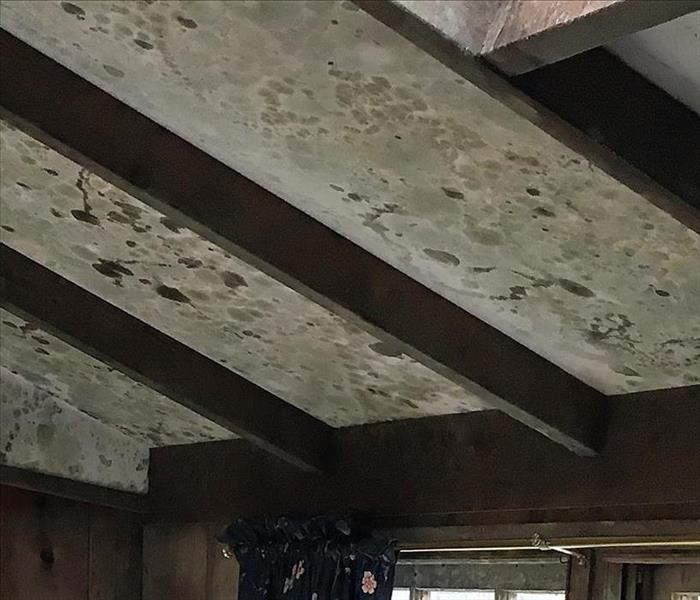 If a home has been damaged by water, mold can grown within 24 hours.
If a home has been damaged by water, mold can grown within 24 hours.
It has been 6 months since tornadoes and microbursts damaged hundreds of houses in the Oxford area.
Storms of that magnitude are an unusual event in Connecticut and most of us were surprised by the level of damage. Many homeowners were forced to leave their homes that had been damaged by water and fallen trees.
Unfortunately, the damage from the storm is still affecting homeowners. Our office has recently been receiving an influx of phone calls from residents who are discovering mold growth in their vacant homes.
It doesn’t take much for mold to grow and with the amount of water present in many of these storm damaged houses, mold is easily growing.
The crew of SERVPRO of Milford-Orange-Stratford holds certifications in the IICRC Applied Microbial Remediation Technician and Mold Removal Specialists and are the area's experienced professionals in mold remediation.
We use various containment procedures, including advanced containment procedures like negative air chambers to prevent the spread of mold. Our specialized filtration equipment, such as air scrubbers and HEPA vacuums, allows our technicians to capture microscopic mold spores out of the air.
We’ll use antifungal and antimicrobial treatments to eliminate mold colonies and to help prevent new colonies from forming. It may be necessary to remove and dispose of mold-infested porous materials, like drywall and carpeting, to remediate heavy mold growth.
We clean your furniture, decorative items, curtains, clothing, and other restorable items affected by mold. We use a variety of cleaning techniques to clean and disinfect your belongings. We’re also trained to remove odors and deodorization using fogging equipment.
When the mold levels have been reduced to be normal levels, our building services team will rebuild any areas of your home that require it, leaving your home better than ever.
If you see signs of mold growing on your walls, ceilings or floors, call us at (203)301-0500 to schedule an inspection.
The Truth About Mold in New Haven County Homes and Businesses
10/15/2018 (Permalink)
 SERVPRO of Milford-Orange-Stratford remediates the mold problem in your home, bringing mold spores down to safe levels.
SERVPRO of Milford-Orange-Stratford remediates the mold problem in your home, bringing mold spores down to safe levels.
You might notice that some restoration businesses advertise “mold removal” and may even guarantee that they will remove all mold, which is a fallacy.
It is impossible to remove all mold from an environment. At SERVPRO of Milford-Orange-Stratford, our technicians remediate mold, bringing the levels to natural and safe levels.
The truth is that microscopic mold spores naturally occur almost everywhere, both outdoors and indoors. This makes it impossible to remove every single mold spore from the air. In mold remediation, our aim is to reduce the mold spore count back to its natural level.
Consider the following facts about mold.
- Mold spores are microscopic and present naturally both indoors and out. They may enter your home through windows, doors, or AC/heating systems or even enter on you or your pet.
- Moisture is essential to the existence of mold spores. When exposed to water, spores quickly form into colonies. These colonies may produce allergens and irritants.
- Prior to beginning any mold remediation, the source of the water or moisture must be corrected. Otherwise, the mold may return.
- The strong, musty odor that mold often produces can lead you to problem areas.
- Standing water isn't necessary for mold to grow. Even higher-than-normal indoor humidity can support mold growth. Keep indoor humidity below 45 percent.
If you have signs of mold, Milford-Orange-Stratford can inspect and assess your structure. We have the specialized training, equipment, and expertise to remediate your mold infestation and bring your mold spore count to safe, natural levels.
While you are waiting for our mold technician to arrive, turn off the HVAC system and any fans in your home as these can cause the mold spores to spread. We also advise that you do not disturb the mold. This includes any attempts to clean the mold yourself. Household cleaners and even bleach are comprised mainly of water, which can actually encourage mold growth on porous surfaces.
Not all levels of mold are going to create toxic conditions in your Woodbridge area home. If you see or smell signs of mold, give us a call for an inspection at (203) 743-5362.
Will My Insurance Company Cover Mold Growth in My Milford Home?
7/16/2018 (Permalink)
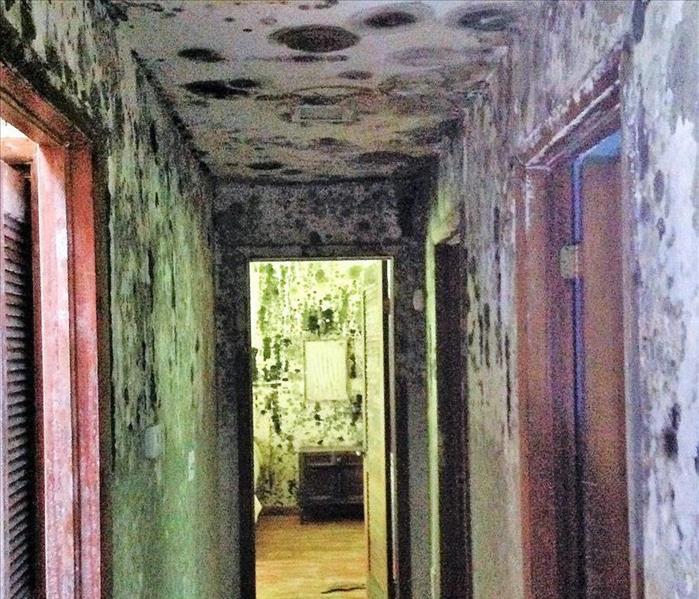 If not immediately treated, mold can quickly spread throughout a home, causing extensive mold damage that may not be covered by your insurance agency.
If not immediately treated, mold can quickly spread throughout a home, causing extensive mold damage that may not be covered by your insurance agency.
When a homeowner discovers that mold is growing behind their walls, in their attic or under their carpeting, one of their first questions is whether the mold will be covered under their insurance policy.
Although there is no universal answer to that question, as homeowner's insurance policies are unique from provider top provider, there are some general guidelines that most insurance companies adhere to.
Typically, your homeowner's insurance policy will cover mold remediation if the mold is caused by "covered peril". What this means is that the cause of the mold growth is already covered by your insurance policy. Since mold is caused by high moisture levels, covered cases are generally from water damage claims. In addition, most of the homes that we restore after fire damage also have secondary water damage as a result of firefighting efforts. Because mold growth can happen within 24 hours, even water damage that is being properly addressed can lead to mold growth.
If the mold found in your home is not from a sudden and accidental event, it mostly likely will not be covered. Mold damage that is caused by a water leak or high moisture levels that could have been prevented typically do not fall under a homeowner's insurance policy. Insurance companies expect that a home should be properly maintained and any defects that could lead to mold growth addressed.
A scenario we frequently see is that of a pipe that bursts in the basement. If the homeowner discovers the damage later that evening and calls a restoration company to begin the cleanup, any mold growth caused by this event should be covered. However, if the water and mold damage from a pipe burst isn't discovered for two months because a home has been left vacant with no caretaker while the owners are away on winter vacation, an insurance company may decide that the home was being neglected and deny coverage.
A water leak from a washing machine that has been properly maintained would usually be covered. However, if the machine has old hoses that have been slowly leaking for months, that would be considered neglect and may not be covered.
Roof leaks are also a common cause of mold growth. Attics tend to be high moisture areas that aren't frequently visited. If you find mold in your attic despite having a newer roof that is properly maintained, you may be covered. A roof that has 40 year old shingles is considered past it's life and mold growth at that home may not be covered.
Most homeowner's insurance policies in Connecticut do not cover flood damage. If you have mold growth after heavy waters from a rainstorm leave a few inches of water in your basement, neither the water nor the mold damage will be covered. If you live in a high risk area for flooding you may consider purchasing separate flood insurance for your home.
Prevention is the key to avoiding uncovered mold damage at your New Haven area home. If you notice high moisture, damp areas of carpeting, buckling of vinyl or wood flooring or water stains on your ceiling or walls, do not ignore it! All of these are signs that there is a leak or high levels of moisture that can cause mold growth. As tempting as it may be to turn a blind eye to potential issues, acting on them quickly can save you thousands of dollars in the end.
If, despite proper home maintenance and vigilance, you still worry about mold in your home, a separate mold insurance rider can be purchased from most insurance companies.
If you see black, green or any shade of mold growing in your home, give us a call at (203) 301-0500. Our IICRC mold remediation professionals will inspect your home, find the source of the mold and advise you on a corrective course of action.
Attic Mold Causes and Remediation in New Haven County Homes
6/13/2018 (Permalink)
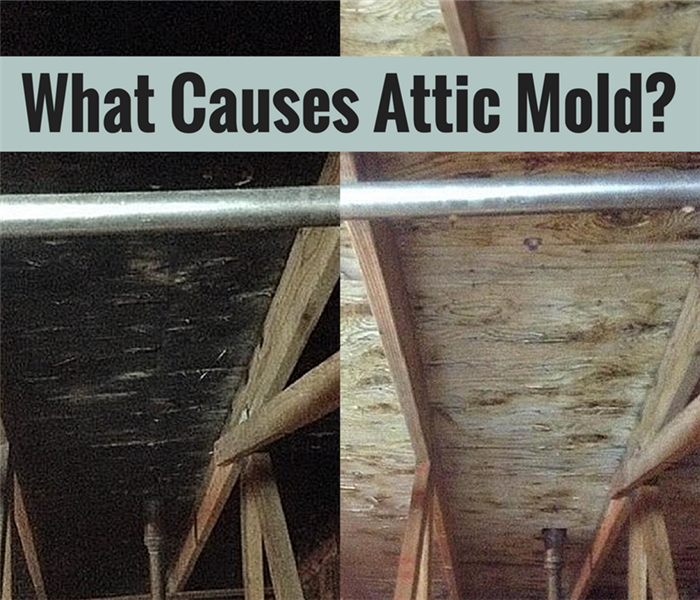 Mold in the attic of your Milford area home can be caused by improper ventilation and insulation as well as leaking appliances and roof leaks.
Mold in the attic of your Milford area home can be caused by improper ventilation and insulation as well as leaking appliances and roof leaks.
Summertime has the phones ringing in our Woodbridge office from homeowners who have discovered mold in the attic of their home. Mold in the attic can compromise the air quality in your home and, if left untreated, can spread to other areas as well. Often hidden in a space few of us visit regularly, attic mold has a few common causes: a leaking roof, inadequate attic ventilation, the wrong type of insulation and appliance leaks and failures. Attic mold is avoidable with some precautions taken and vigilance.
A Leaking Roof
Inspect your attic seasonally for signs of water damage such as wet insulation, stains on plywood and black spots that could be mold. Leaks are common around plumbing stacks as well as the area where two roofs join. If you have recessed lighting, check the canisters for rust or corrosion. This is an indicator of high moisture levels.
Attic Ventilation
New Haven County homes typically have attics with soffit, ridge and gable-mounted vents. Having adequate ventilation is important because condensation can’t escape your attic without it. We have inspected several homes for mold in which there is not the proper number of vents in the attic, or in which they are improperly installed. Also check to make sure that your vents are not blocked by insulation or stored boxes.
Dryer vents, plumbing vents, kitchen or bathroom fans that are vented into the attic can also create moist conditions. If yours are installed this way, contact a professional to re-route them outside.
A Well-Insulated Attic
If your insulation is installed incorrectly, or the wrong type of insulation has been used, moisture from the lower levels of your home can get trapped in the attic. This can feed mold growth. If you’re layering insulation atop other insulation, don’t use the kind that has “kraft face” finish (i.e., paper or foil backing). It acts as a vapor barrier and can trap moisture in the insulation. Check the condition of your insulation- it should be thick, soft and dry.
Appliances Installed in the Attic
In many newer homes, air conditioners, swamp coolers, and HVAC systems are installed in the attic space. There is the possibility that these may fail and cause water damage. A small, undetected leak in the attic can cause a mold disaster so have your system inspected regularly.
If you find mold in your attic space, give our office a call at (203) 301-0500. We will come out and inspect your attic and advise you on a course of action.
How to Manage Black Mold Growth in Your Stratford, CT Restaurant Kitchen
5/6/2018 (Permalink)
 Not all black mold found in commercial restaurant kitchens is this obvious. It is often hidden behind baseboards, appliances and ceiling tiles.
Not all black mold found in commercial restaurant kitchens is this obvious. It is often hidden behind baseboards, appliances and ceiling tiles.
Mold found in the kitchen of your restaurant can have serious implications for your business.
Restaurant kitchens are some of the busiest work spaces. They function all day, every day, and require a smooth running operation to be successful. One malfunction, such as a freezer breaking down, a small grease fire on the range or a dishwasher not working, can throw everything off. Finding mold in your kitchen presents a host of challenges for restaurant owners. Quarantining food and prep surfaces in a high-volume restaurant can be a difficult task yet closing your restaurant during treatment is not a viable option.
Mold growth requires moisture, which is always found in commercial kitchens.
The number one ingredient that mold needs is moisture, which is always present in a commercial kitchen. The ever-running dishwasher from which water is sprayed, leaked and steam created is a major source of moisture in restaurant kitchens. Many kitchens have rubber floor mats, which effectively create a non-slip surface for kitchen workers, but also often trap water underneath and in the crevices. These mats are typically picked up when the floor is mopped at the end of the night but not always fully dry when they are replaced. Many kitchens have ceiling tiles, which are great in that they can be replaced if damaged, however can also be a breeding ground for mold spores due to their porosity. Ceiling tiles also trap dirt, which is a food source for mold. With multiple ice machines, refrigerators and freezers, commercial kitchens are also susceptible to supply line leaks, which can often go unnoticed until a mold infestation is discovered. No matter how carefully your restaurant kitchen is cleaned each night, it is a challenge to keep it dry enough to deter mold.
The best deterrent for mold growth in your kitchen is vigilance.
Working a weekly mold check into the kitchen cleaning schedule will help catch mold before it is a problem.
- Look behind each appliance for any leaks or puddles. Inspect that there isn't irregular condensation under or on the outside of freezers and coolers.
- A common place mold starts is the area is behind the vinyl baseboard, which sometimes lifts after time. Have baseboards inspected for any damage or moisture.
- Inspect ceiling tiles for discoloration that can be caused by a leaking pipe or faulty exhaust fan.
- Check the walls and floors around dishwashers and sinks for any signs of moisture- crumbling drywall, peeling linoleum or cracked tiles can all by caused by standing water.
- Also inspect bathrooms, which often share walls with the kitchen for any signs of mold as mold spores can infiltrate walls and move through the air from room to room.
Treating mold found in your restaurant kitchen.
Although mold found in a private home can be occasionally cleaned by the homeowners, mold found in commercial kitchens always requires professional remediation. At SERVPRO of Milford-Orange-Stratford, we don't like to use scare tactics in order to get business. However, mold in your restaurant kitchen can be a health hazard to your employees and your customers and if it is not contained and remediated properly, it can be seriously impact your business and your ability to keep your doors open. Our team is IICRC certified in mold damage remediation and experienced in commercial mold restoration in the New Haven County area. When we come to your commercial property, we will contain the area to stop the spread of mold spores and identify the sources of water that is causing the mold growth. Once moisture levels are down and the damaged material has been removed, we clean the air with air scrubbers to filter out the mold spores. When the mold remediation is complete, our construction team will replace wallboard, flooring, ceiling and any other material that required removal. We do all of this with the least disruption to your business continuity as possible.
If you find mold in your kitchen, give us a call at 203-301-0500 for an inspection and treatment plan.
Microscopic Mold Spores
1/4/2018 (Permalink)
Microscopic mold spores naturally occur almost everywhere. This makes it impossible to remove all mold from one’s residence or business.
Therefore, mold remediation reduces the mold spore count back to its natural or baseline level.
Some restoration businesses advertise “mold removal” and even guarantee to remove all mold, which is a fallacy. Consider the following mold facts:
- Mold is present almost everywhere, indoors and outdoors.
- Mold spores are microscopic and float along in the air and may enter your home through windows, doors, or AC/heating systems or even hitch a ride indoors on your clothing or a pet.
- Mold spores thrive on moisture. Mold spores can quickly grow into colonies when exposed to water. These colonies may produce allergens and irritants.
- Before mold remediation can begin, any sources of water or moisture must be addressed. Otherwise, the mold may return.
- Mold often produces a strong, musty odor and can lead you to possible mold problem areas.
- Even higher-than-normal indoor humidity can support mold growth. Keep indoor humidity below 45 percent.
If you see signs of mold, please contact SERVPRO of Milford-Orange-Stratford at 203-301-0500. We are here to help and have specialized equipment and expertise to help remediate your mold infestation.
Does Insurance Cover Mold?
1/4/2018 (Permalink)
On a weekly basis we are called in to inspect mold. With much attention around black mold and its potential to be toxic to one’s health, many homeowners’ don't want to take a chance when they see mold. However, not every home that we inspect requires professional remediation. Often enough, we recommend a safe method in which homeowner's can reduce their mold exposure and/or treat it themselves.
In the cases where there has been a mold infestation and our services were required, homeowners were surprised when their home-owner’s insurance did not cover mold remediation.
Some policies will cover mold under certain circumstances, while other policies may exclude mold. Typically, if your policy does not include mold remediation it can be added. However, we recommend that you call your insurance agent to learn more about mold coverage. It can be a preventative measure that can save you thousands.
If you see signs of mold please don’t hesitate to call SERVPRO of Milford-Orange-Stratford at (203) 301-0500.
Safety Precautions When Dealing with Mold
11/28/2017 (Permalink)
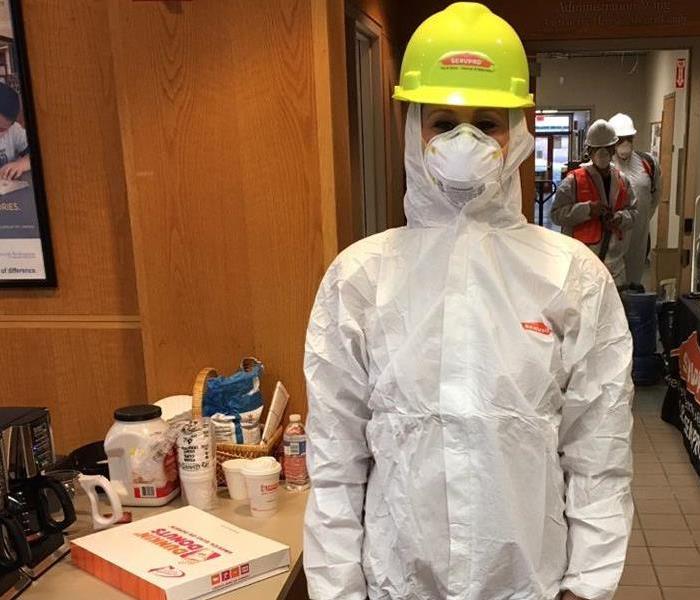 Gearing-up!
Gearing-up!
SERVPRO of Milford-Orange-Stratford follows strict protocols when removing mold. We are a group of highly trained professional ready to restore your property back to pre-disaster conditions, if not better! We are the experts in mold remediation and restoration for residential and commercial properties.
It is important that safety precautions are used when dealing with any size disaster, especially when dealing with mold. Water & Mold losses have the potential to cause major damage to structures if not handled properly. Cleanup can be extremely overwhelming, so let us help you take back control of your property. We are available, prepared and here to handle in any size disaster 24/7.
Should you suspect mold, please don’t hesitate to call us or for additional information visit us at www.SERVPROmilford.com.
10 Things to Know About Mold
11/27/2017 (Permalink)
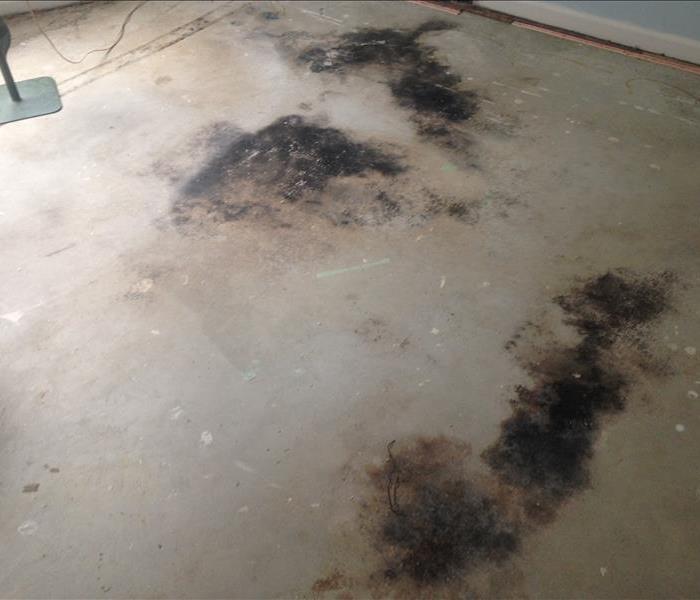 Black Mold
Black Mold
10 Things to Know About Mold:
According to the United States Environmental Protection Agency (EPA), there are 10 things you should know about mold:
- Potential health effects.
- No practical way to eliminate mold; the best way is through moisture control.
- If mold becomes a problem, you must clean up mold and eliminate the source of moisture.
- To prevent mold growth, find the source and fix the issue.
- Reduce indoor humidity by venting bathrooms, dryers and other moisture sources outside. Use air conditioners and de-humidifiers.
- Clean and dry damp or wet materials quickly to prevent mold growth.
- Should mold be present, clean surfaces with detergent and dry completely. Materials like ceiling tiles, sheet rock and etc, should be replaced.
- Prevent condensation.
- In areas where there is a moisture problem, do not install carpeting.
- Mold can be found almost anywhere and can grow on just about anything.
For more information on mold visit www.epa.gov.
Steps To Help Minimize Your Risk To Mold In Your Home
11/27/2017 (Permalink)
Steps to help minimize your risk to mold in your home:
- Caulk around water fixtures – this includes, sink, shower, toilet, and windows.
- Use mold inhibiting paints in bathroom and other damp areas
- Use a fan in the bathroom which exhausts outdoors
- Vent clothes dryer outside
- Clean refrigerator and air conditioner drip pans
- Don’t for get to clean your gutters – standing water in your gutters can leak into the eaves and potentially exterior walls.
- Roof – check the attic for roof leaks
- Basement and crawl space – check for moisture or standing water. Consider using a dehumidifier in your basement.
- Consider sealing dirt basement and crawl spaces.
- Water damage - clean it up immediately.
Should you experience a water loss please contact experts who specializes in water & mold mitigation. They will properly extract and dry out the affected areas. Even minor floods have the potential to cause major damage to a structure when not treated properly. Cleanup can often be an overwhelming task, so call SERVPRO of Milford-Orange-Stratford, we are prepared to handle any size disaster.
Local Business Experiences Mold
11/27/2017 (Permalink)
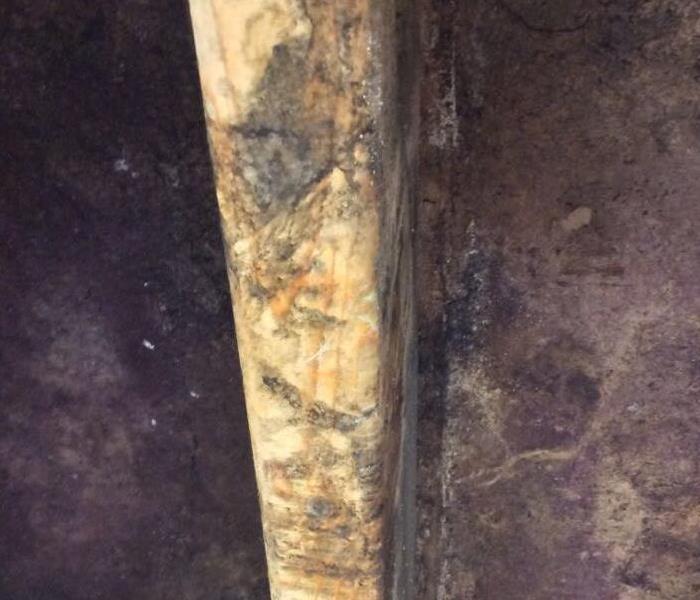 Mold behind sheet rock.
Mold behind sheet rock.
This is a picture from a local business that experienced mold growth behind a sheet rock wall which neighbors to another business. Overtime, the business owner noticed a strong musty odor and decided to further investigate. After moving around large bulky furniture, they noticed a discoloration and bulge in the sheet rock wall and thereafter, called SERVPRO of Milford-Orange-Stratford. We arrived on scene and carefully inspected for any visible signs of mold. Our workers set up containment procedures to keep the mold spores from spreading during the cleanup process. We also set up equipment like air scrubbers and HEPA vacuums which captured the microscopic mold spores from spreading while remediation was in process.
Also, we used an anti fungal and antimicrobial treatment to eliminate mold from forming and disposed of the heavy contaminated mold growth materials. Lastly, restoration begins; we replaced drywall, re-painted and gave them a fresh clean look.
Should you suspect mold, please contact us at 203-301-0500. Minor losses have the potential to cause major damages when not treated properly. Cleanup can often be an overwhelming task; however, we are prepared 24/7 to handle any size disaster.





 24/7 Emergency Service
24/7 Emergency Service
